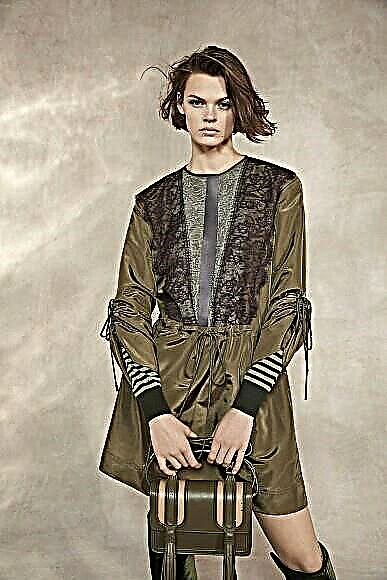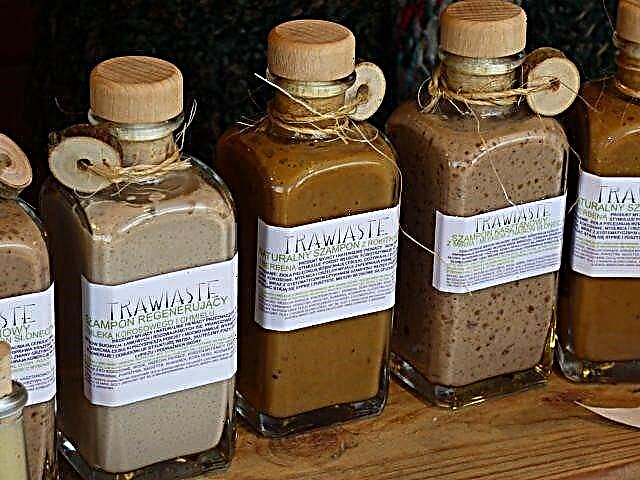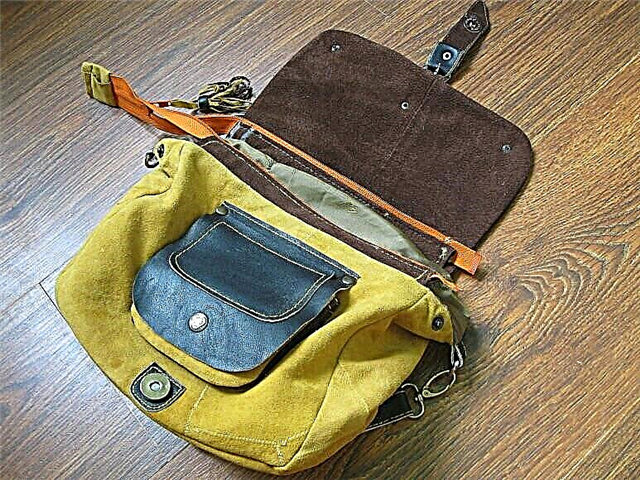Share
Pin
Tweet
Send
Share
Send
A beautiful knitted dress looks spectacular thanks to the original cut of the neck and skirt.
You will need
Knitted fabric with elastane 145 cm wide for sizes 34−44 - 1.50 m; • ironing pad interlining G 785 0.10 m 90 cm wide; • non-woven formband; • threads for sewing; In addition: • silk paper for transferring patterns from a sheet of patterns; • pencil; • paper scissors; • tape measure; • tailor pins; • "magic" tailor's crayon; • scissors for cutting and small scissors for needlework; • sewing machine needle and manual sewing needle.Length from waist 58 cm.

Recommended fabrics: only knitted fabrics with elastane.
Dress pattern
... pink, so it is easy to find on the sheets of patterns. Put silk paper on a sheet of patterns and pin it. Translate the details of the pattern of your size along the corresponding contour lines and do not forget about the marking and inscriptions.
Re-shoot part 3 twice. There are no special paper patterns for hemming and loops. Draw these details directly on the knitted fabric, dimensions see below.

Extra-pattern of pink color on the sheets of patterns, A and B
A: parts 1 and 3
B: item 2
Tip: the size of the dress is determined by the circumference of the chest (size 34 = 80 cm;
size 36 = 84 cm, size. 38 = 88 cm, size 40 = 92 cm, size. 42 = 96 cm, size 44 = 100 cm).
Layout plan
... shows how to arrange the details of a paper pattern on a knitcanvas. Pin the details of the paper pattern / trace the details on the fabric.

Knitted fabric with elastane shir. 145 cm
Sizes 34−44
Cut
1 Before 1x2 Back, one-piece with strap 1x
3 Cloth skirt 2x
a, b, c) grooves with a width of 4 cm: a) groove of the neck of the front with a length of 41–43–44–46–47–48 cm; b) turning the right armhole length 41–42−44−45−46−46−47 cm; c) turning of the left armhole of the back 10 cm long;
d) belt loops 10 cm long and 7.5 cm wide.
Sewing

Step 1: Cut
Lay the knitted fabric in one layer face up. Place the details of the paper pattern 1 and 2, as well as the front panel of the skirt on the knitted fabric with the side with the inscriptions up, the back panel of the skirt with the side with the inscriptions down. Pin it up. Mark around the details of the pattern with “magical” small stocks: 1.5 cm across the cuts of a whole-cut shoulder strap and shoulder sections (pink lines), 1 cm along the remaining sections and seams, there are no allowances for hemming the bottom of the skirt panels. Draw the stitches (a, b, c) and the loops (d). Cut out the details. Step 2 ">
Step 2 ">Step 2: seam lines and marking
If you cut the parts exactly along the drawn allowance lines, then the lines of the seams and the lower edges on the cut parts can not be transferred. Cross marks for attaching shoulder straps (front neck) and a transverse mark of the shoulder seam (control mark 2 on the back), as well as the lines of folds and seams of the folds on the straps, use a cutter to translate patterns and carbon paper (see the detailed instructions on the paper packaging) . Transfer these lines to the front side with large counting stitches.
Step 3: privitize non-woven
Iron the non-woven fabric bands from the wrong side along the sections of the armholes and the neck section of the front, while the chain seam on the non-woven should lie at a distance of 1 cm from the sections of the cut parts. Iron thermostat in the "SILK" position, drive the iron over the non-woven for approx. 8 seconds Cut 2 strips of non-woven G 785 approx. 55 cm and a width of 2 cm and iron from the wrong side along the lower sections of the front and back.
Step 4: stitch the skirt panels
Pin the front panel of the skirt to the lower section of the front, the rear panel of the skirt to the lower section of the back with the front side to the front side. Stitch (with 1 cm wide allowances). Bind at the beginning and end of the stitches. Overlock the seams of each seam together and iron up.
Step 5: the neckline
Fold the front neckline (a) along the front half in half. Iron.Pin the facing from the front side to the cut of the front neck, aligning the open sections of the facing with the edge of the allowance along the neck section. Stitch at a distance of 1 cm. Cut the seam allowances close to the stitch. Unscrew the obtachka on the wrong side, take it. Iron the edge, but do not cut it off yet.
Step 6: left armhole of the back
Press the hem © twice (see step 5) and stitch it to the section of the left armhole of the back from the side section to the corner. On the back allowance, notch close to the last stitch of the stitch. Seam allowances close to the seam. Unscrew the obtachka on the wrong side. Iron the stitch and stitch at a distance of 5 mm.
Step 7: Right Shoulder Stitch
Before laying on the back, face to face. Chip off the right shoulder sections by aligning the edge of the neck of the front with the transverse mark of the back (reference mark 2, see step 2). Make a shoulder seam (with 1.5 cm wide allowances). Iron the seam allowances on the back until you are sewing.
Step 8: shoulder straps
Press the allowances along the longitudinal sections of the shoulder strap 1.5 cm wide onto the wrong side, tuck them up to a width of 7 mm, and diagonally under the allowances of the shoulder seam. Iron. Overlock the right shoulder seam allowances. Stitch the longitudinal edges of the strap at a distance of 5 mm: the upper edge - to the shoulder seam, the lower edge - to the finishing line of the left armhole of the back.
Step 9: Stitch the creases on the straps
Fold the strap along the fold line of one fold with the wrong side inward. Along the fold, lay the stitch along the marked line of the seam of the fold (at a distance of 1.5 cm). Stitch 2 more folds in the same way.
Step 10: Right Armhole
Press the hem of the right armhole (b) in half (see step 5) and stitch it with the front side to the right armhole section to the front side (with allowances 1 cm wide). Cut the seam allowances close to the stitch. Unscrew the obtachka on the wrong side, iron the armhole and stitch at a distance of 5 mm.
Step 11: side seams
Before laying on the back, face to face. Chip off the side sections by aligning the seams of the sewing on the skirt panels. Grind (with allowances 1 cm wide). Iron the seam allowances and overcast. Sew the upper ends of the seam allowances by hand to the edge of the neck.
Step 12: tuck up the end of the straps
To complete the assembly along a short section of the strap at a distance of 1.2 cm, lay the machine stitch with large stitches. At a distance of 5 mm from this stitch, lay another stitch. Hold the bottom stitches firmly, pull the cut on the threads of the sewing stitches to the length: for size. 34 - 9 cm, for size 36 - 9.5 cm, for size 38 - 10 cm, for size 40 - 10.5 cm, for size 42 - 11 cm, for size 44 - 11.5 cm. Tie the threads of the sewing stitches together.
Step 13: Stitch Up The Strap
Turn the front neckline up again. Put the end of the strap on the neck of the front between the transverse marks with the front side to the front side, pin it exactly into the seam of the grind. Stitch after fitting.
Step 14: stitch the neckline
Turn the neckline of the front and the seam allowance for sewing the straps on the front, pin. Stitch the front neck at a distance of 5 mm, securing the hem and shoulder strap.
Step 15: belt loops
Press the longitudinal sections of the loop (d) onto the seamy side, 2.5 cm wide. Press one end of the loops on the seamy side, 1.5 cm wide. Sew manually.Dress 110 from the magazine BURDA 2/2013
Share
Pin
Tweet
Send
Share
Send






